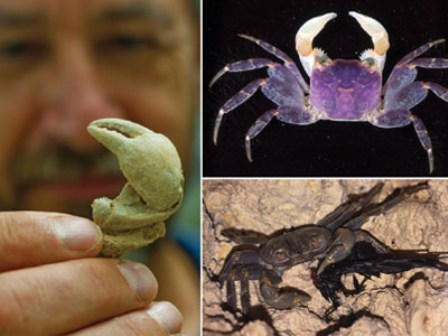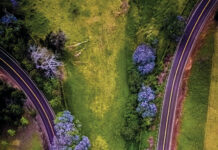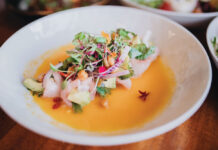Story by Shannon Wianecki
 Next time you’re hiking through a Hawaiian forest, imagine fist-sized crabs skittering underfoot. According to Florida invertebrate zoologists Gustav Paulay and John Starmer, a large land crab once called Hawaii home. While scientists have long known that terrestrial crustaceans crawled across these Islands, no one had puzzled out exactly which species, what their habits were, or why they disappeared.
Next time you’re hiking through a Hawaiian forest, imagine fist-sized crabs skittering underfoot. According to Florida invertebrate zoologists Gustav Paulay and John Starmer, a large land crab once called Hawaii home. While scientists have long known that terrestrial crustaceans crawled across these Islands, no one had puzzled out exactly which species, what their habits were, or why they disappeared.
Paulay and Starmer investigated fossilized crab shells at the Smithsonian and the Florida Museum of Natural History. In May of 2011, they determined that the Hawaiian specimens belonged to a unique species, new to science. They named it Geograpsus severnsi, after Maui shell collector Mike Severns. Endemic to the Hawaiian Islands, Geograpsus severnsi roamed further inland (three miles) and to higher elevation (3,000 feet) than crabs elsewhere in the Pacific.
According to Paulay, the Hawaiian land crab was abundant prior to human contact. Like all terrestrial crabs, Geograpsus severnsi evolved from marine ancestors and returned to the ocean to spawn. During migration, when females traveled en masse to deposit fertilized eggs in the sea, the crabs were particularly vulnerable. They would have been easy prey for new predators. Shortly after humans and their attending dogs, rats, and pigs rolled ashore, the Hawaiian land crab vanished from the earth.
More than just an interesting factoid, this discovery snaps an important piece into the puzzle of Hawaiian ecology. Land crabs play key environmental roles throughout Oceania. With their hefty, serrated claws, these roving omnivores prey on nesting sea birds, eggs, insects, and plants. They disperse seeds and help cycle nutrients in the soil; their removal can lead to large-scale ecological shifts. On Christmas Island, where the native crab population is under attack by invasive ants, changes in the forest structure can already be seen.
Now when Hawaiian land managers devise strategies for forest conservation, they have more information about missing players and the crucial functions they once served.




















